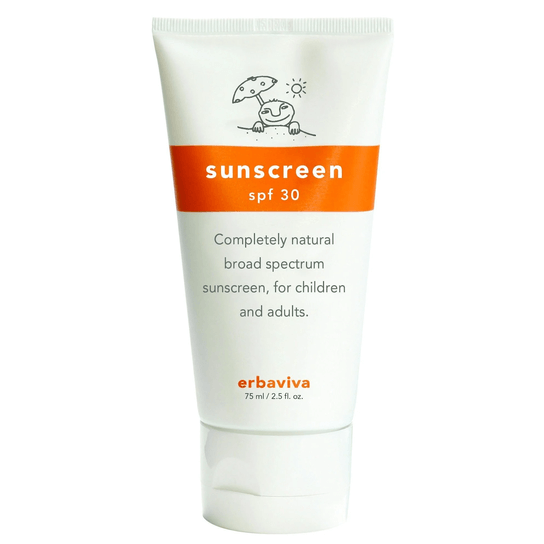Sunscreens are essential to enjoy the sun without having to deal with the possible side effects of too much sunlight exposure. The problem is that not all sunscreens are equally effective—and safe, for that matter. So what makes a healthy sunscreen, and how can you be sure of the product you pick?
What Makes a Healthy Sunscreen?
In 2019, the Environmental Working Group (EWG)(1) published its annual guide to sunscreens—a massive overview of facts, recent studies, and important statistics. The report looked into the fundamental traits of a healthy sunscreen and the common issues that all customers should know.https://www.ewg.org/sunscreen/
For instance, here are some of the most important characteristics of a healthy sunscreen, according to the EWG standards:
- Healthy sunscreen ingredients should not cause skin irritation or allergy. Since sunscreens should be applied generously over large areas of the body, the safety of the product’s ingredients is crucial. Healthy sunscreens are skin-friendly even when applied in a thick coat and for a long time.
- The sunscreen’s ingredients should withstand ultraviolet (UV) radiation. Some sunscreen components gradually lose effectiveness after prolonged exposure to UV radiation, others break down into harmful byproducts. Healthy sunscreens contain only UV-resistant ingredients.
- Healthy sunscreens should not contain ingredients that lack safety data. Not all compounds in the most common sunscreens have been evaluated by the FDA or researched in high-quality studies. The best sunscreens contain only reliable substances with a scientifically proven safety profile.
- Healthy sunscreens should not have needlessly high SPF levels. It’s a common misconception that the higher a sunscreen’s SPF is, the better it works. In fact, sunscreens with an SPF above 50 may be dangerous for health due to their higher content of filter substances and the imbalanced protection they provide under an imparted false sense of safety.(2) At the same time, the added benefits from higher SPF levels are just marginal at best, so healthy sunscreens usually feature an SPF of 50 or lower.
- Healthy sunscreens provide protection both against UVA and UVB. Sadly, many sunscreens sold in the US focus mainly on UVB radiation and provide inadequate protection against UVA. Healthy sunscreens protect the customer from both types of ultraviolet rays.
What Maxes Toxic Sunscreens?
Now that you know what the traits of a healthy sunscreen are, let’s turn to the dark side of the matter and check what are the possible dangers of toxic sunscreens.
- The ingredients of toxic sunscreens are absorbed into the blood. A recent study published in the Journal of the American Medical Association (JAMA) reported that some of the most common chemical filters (oxybenzone, for example) used in popular sunscreens enter the bloodstream and reach potentially toxic levels in the first day of use.(3)
- Toxic sunscreens may disrupt hormonal health. Studies reported that some UV filters can mimic hormones in the body, causing hormonal disruption. For example, benzophenones (BP) affect female and male sex hormones—estrogens and androgens.(4)
- Toxic sunscreens may be dangerous during pregnancy. Studies have reported that women who had high oxybenzone levels in their bodies were much more likely to give birth to a baby with Hirschsprung’s Disease, a severe defect of the gastrointestinal tract.(5)
Top 20 Healthy Sunscreens for 2020
2020 is about to begin—so what are this year’s best sunscreens? Guided by the EWG standards, we looked through the ingredients, customer reviews, protection effectiveness, and health benefits of hundreds of sunscreens available right now to find which ones you should trust. While we wait for the next annual EWG report, here are the top 20 healthy sunscreens to protect your skin in 2019 and 2020!
1. Erbaviva Sunscreen – SPF 30
We kick off our list with the best all-natural sunscreen: Erbaviva Sunscreen SPF 30. This product provides effective protection against both UVA and UVB radiation using only minerals (zinc oxide) and plant oils (jojoba, aloe, olive, sunflower). No shady ingredients, no risky chemicals, supreme natural protection for the whole family.
2. True Natural Neutral Sunscreen Lotion, Sensitive Skin – SPF 50
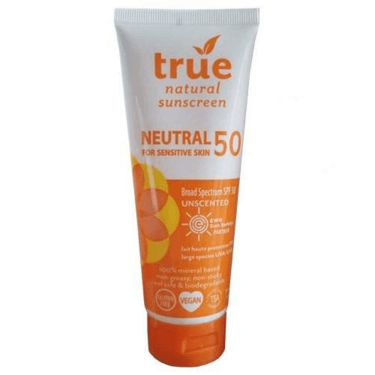
In 2020, the best sunscreen for sensitive skin is the True Natural Neutral Sunscreen Lotion, SPF 50. Featuring a vibrant bouquet of soothing botanical ingredients like green tea, coconut, and jojoba oil, this sunscreen is perfect for people who often have trouble with finding a skin product their skin would tolerate well.
3. Adorable Baby Sunscreen Stick, SPF 30+
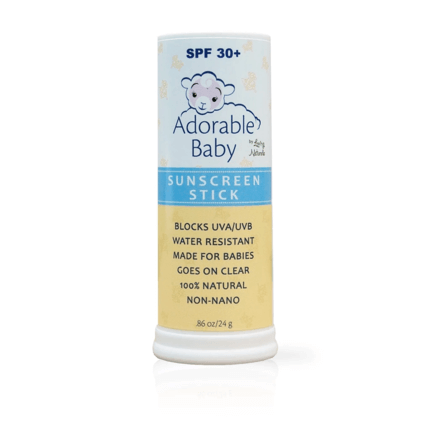
A baby’s skin has unique properties, and that’s why it always needs special treatment. Right now, the best sunscreen for babies is the Adorable Baby Sunscreen Stick, SPF 30+. Super easy to apply, it features an outstanding UVA/UVB protection balance based on safe and gentle ingredients with zero safety concerns. Perfect for any baby!
4. Aveeno Baby Continuous Protection Sensitive Skin Zinc Oxide Sunscreen Lotion, SPF 50
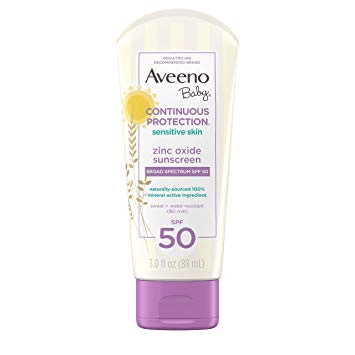
Some babies have extra sensitive skin, and even sunscreens created specifically for babies aren’t gentle enough for them. For such cases, the best sunscreen for babies with sensitive skin is this all-natural product from Aveeno. Fragrance-free, paraben-free, phthalate-free, tear-free—and with a skin-soothing formula created to keep your baby’s skin well-hydrated and nourished at all times.
5. Waxhead Sun Defense Zinc Oxide Vitamin D Enhanced Sunscreen Lotion, SPF 35
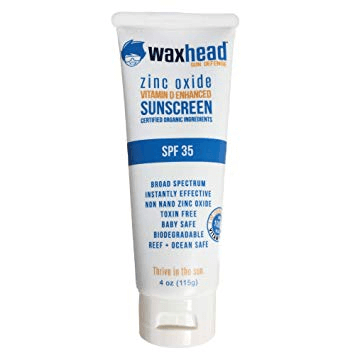
Vitamin D deficiency is a common health concern worldwide, and using too much sunscreen could potentially worsen the issue. To help you get more of this vital nutrient, consider trying the best sunscreen with vitamin D, Waxhead Sun Defense.
Just in case, we recommend discussing the matter with your physician before taking any vitamins in any form. Remember, you need them ONLY if you have a CONFIRMED vitamin deficiency.
6. 3rd Rock Sunblock Sunscreen Lotion, Aromatherapeutic, SPF 35
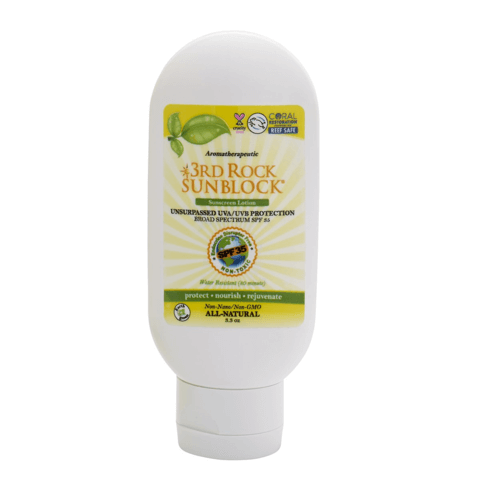
For those who value a good aroma in everything they put on, the best aromatherapeutic sunscreen is the 3rd Rock Sunblock Sunscreen Lotion. Featuring a vibrant fragrance with frankincense, rosemary, and orange, this lotion often feels like a perfume more than a sunscreen. And it STILL provides amazing protection against both UVA and UVB radiation!
7. All Good Sport Sunscreen Lotion, SPF 30

Perfect for people who regularly engage in sports or active play in the sun, the best sunscreen for outdoor sports in 2020 is the All Good Sport Sunscreen Lotion, SPF 30. Water and sweat-resistant for up to 80 minutes, this mineral sunscreen is based on the safe action of zinc oxide. Moreover, its fragrance includes notes of calendula, rose hip, raspberry, and green tea—so it’s not just effective, but also delightful to put on.
8. All Good Sunscreen Butter, Tinted, SPF 50+
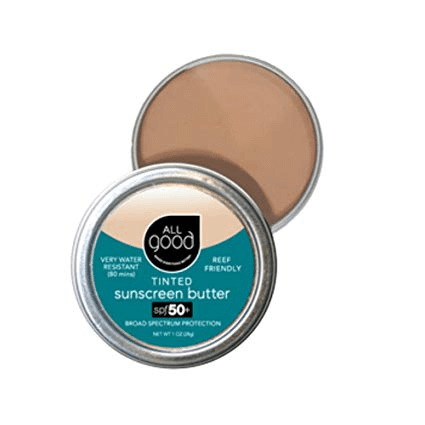
While most people prefer untinted sunscreens, some opt for tinted products to even up their skin tone a bit. If that’s your case, the best tinted sunscreen in 2019 according to EWG is the All Good Tinted Mineral Sunscreen Butter, SPF 50+. It’s super easy to apply thanks to its creamy texture, and its shade blends fabulously with most skin tones.
Please, keep in mind that tinted sunscreens can leave a mark on light fabrics. In this case, use household or dish soap to scrub the stain before washing the fabric following the usual instructions.
9. Kabana Organic Skincare Green Screen D Sunscreen Lotion, SPF 35
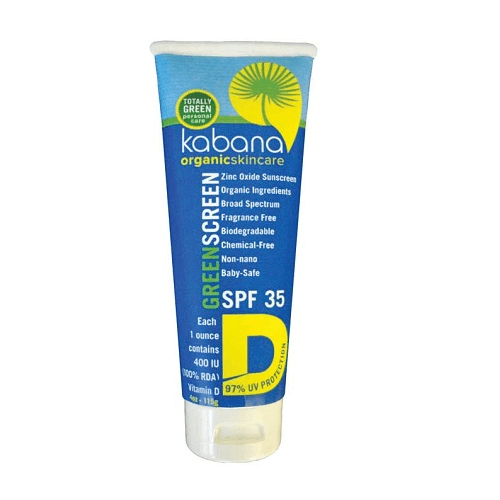
It’s always great to buy and use organic, super safe, and environment-friendly products. They often come at a price, though. As an alternative, try the Green Screen D Sunscreen lotion from Kabana Organic Skincare—the best inexpensive sunscreen in 2020! Biodegradable, chemical-free, made with only organic ingredients, this sunscreen is fabulous for all the family, and it won’t break your budget along the way.
10. Loving Naturals Daily UV Cream, Lightly Scented, SPF 20
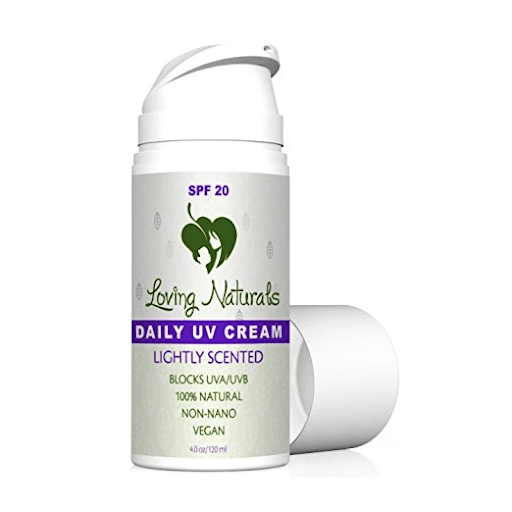
Most beauty & care products are rarely effective for two distinct purposes at the same time, and this is true for moisturizers and sunscreens too. However, there are exceptions! For example, the best sunscreen and daily moisturizer is the Daily UV cream from Loving Naturals. Available in a lightly scented and unscented version, this moisturizer doubles really well as a sunscreen with both UVA and UVB protection.
11. Supergoop! Daily Correct CC Cream, SPF 35
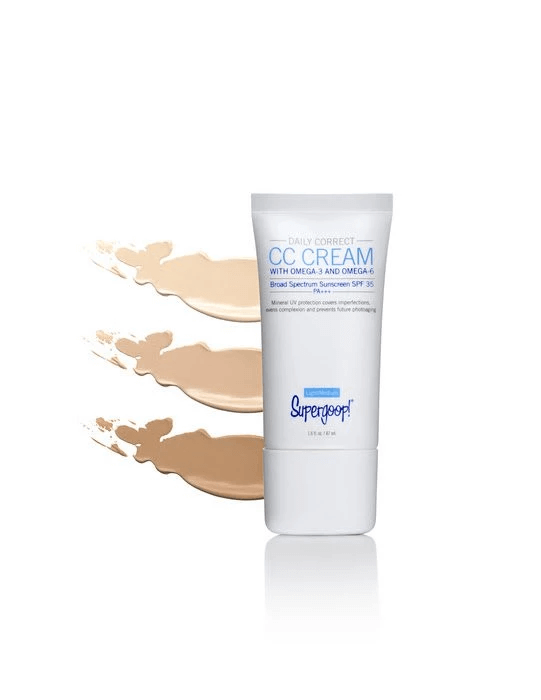
Many makeup products just don’t provide enough protection from UV radiation. If you’ve been looking for a color correcting (CC) cream, the best sunscreen with CC action in 2020 is the Daily Correct CC Cream line from Supergoop! Available in four different shades (fair, light, light to medium, and medium), this product provides outstanding UV protection and color correction that’s on a par with non-sunscreen CC creams. Two in one!
12. Loving Naturals Sunscreen Lip Balm, SPF 30+
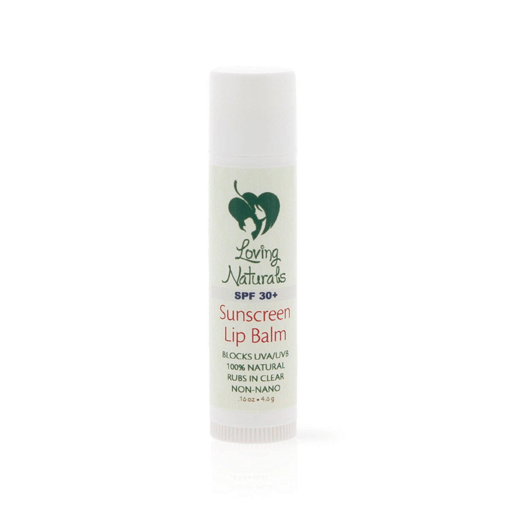
As a rule, you don’t put regular sunscreen on your lips. It tastes weird, feels weird, and is generally not suitable for the gentle skin of the lips. If you struggle with dry lips every time you spend a lot of time in the sun, consider trying the best lips sunscreen in 2020 – the Sunscreen Lip Balm, from Loving Naturals. Zero toxicity, zero safety concerns, absolutely natural, and effective against all types of UV rays.
13. Badger Active Baby Natural Mineral Sunscreen Cream, Chamomile & Calendula, SPF 30
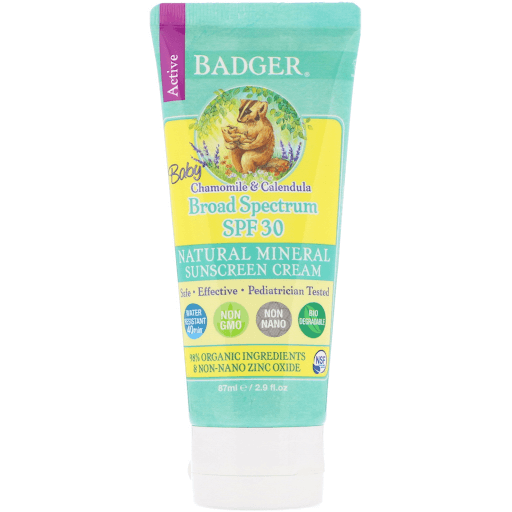
If you’re looking for a quality sunscreen with a strong healing effect to help you heal existing sunburns or skin irritation, try out the Natural Mineral Sunscreen Cream from Badger. It’s the best soothing sunscreen in 2019, thanks to its formula with chamomile and calendula. Originally created with baby skin in mind, it provides great results for adults as well.
14. Andalou Naturals MEN Face Guard Daily Mineral Lotion, SPF 30
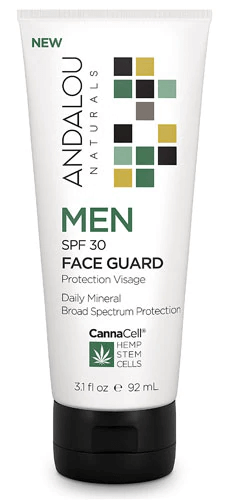
It’s a sad stereotype, but many men avoid using sunscreens because these products feel like makeup to them. If you know a man like that and want to gently nudge them in the right direction of protecting their skin on a daily basis, give them the best facial sunscreen for men: the Face Guard Daily Mineral Lotion from Andalou Naturals. Besides an effective SPF 30 level, this sunscreen features a good dose of fruit stem cells, nourishing botanicals to improve skin hydration, and a robust fragrance with sage, lime, and mint notes.
15. Sanre Shaded Rose Solar Calming Facial Cream, SPF 30
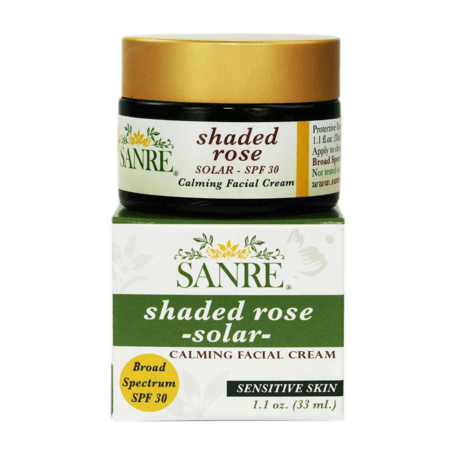
As a rule, the face is one of the first parts of the body to suffer from too much sunlight exposure. When you need a soothing product to enhance regeneration and promote sunburn healing on your face, try out the best facial sunscreen with calming action. The SanRe Shaded Rose calming facial cream gently supports skin healing and provides effective protection against UV rays—with all-natural ingredients and zero safety concerns.
16. Unsun Hand Cream, SPF 15
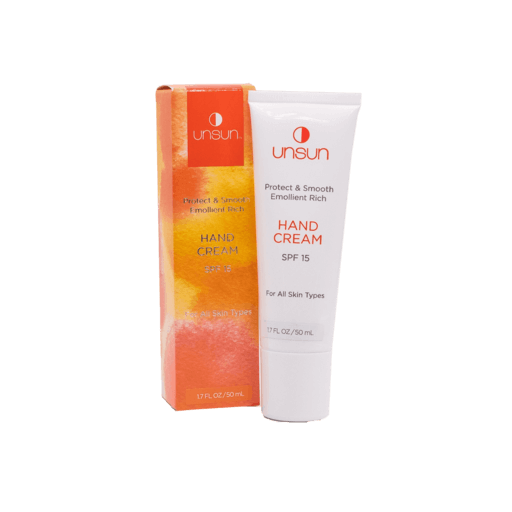
For people with sensitive hands, a dedicated sunscreen is an essential part of their daily beauty and care routine. According to EWG ratings our expert evaluation, the best sunscreen for hands in 2020 is the UnSun Protect & Smooth Emollient Rich Hand Cream, SPF 15. It features a few extra ingredients that improve local absorption of nutrients, and that’s great because the skin on the hands is often much less responsive to cosmetics than the face, for example.
17. Acure Radically Rejuvenating SPF Day Cream, Turmeric, Ferulic Acid & Vitamin C, SPF 30
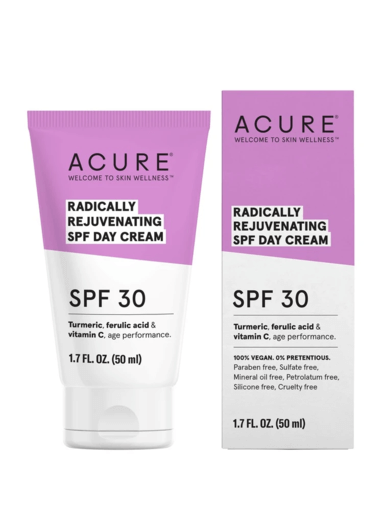
UV radiation triggers the formation of free radicals and reactive oxygen species (ROS) in the skin. Both are major factors that boost oxidative stress, contribute to skin aging, and increase the risk of skin cancer.(6,7) Besides the UV-filtering action of healthy sunscreen products, a good source of extra protection against oxidative stress is using a product with added antioxidants. Well, the best sunscreen with antioxidants right now is the Radically Rejuvenating SPF Day Cream from Acure. Unleash the power of turmeric, ferulic acid, and vitamin C on those pesky radicals!
18. Andalou Naturals CannaCell Sun Buddy Lotion, SPF 30

If you’re looking for a healthy sunscreen with added benefits for your skin’s aging, the best anti-aging and rejuvenating sunscreen is probably the CannaCel Sun Buddy Lotion, from Andalou Naturals. Besides the zinc oxide for excellent UV protection, this sunscreen is packed with antioxidants, hemp stem cells, and phytonutrients to support healthy regeneration in the skin.
19. Attitude 100% Mineral Sunscreen, Fragrance Free, SPF 30

Not everyone wants their sunscreen to smell like Damask roses or orange zest. Moreover, some people avoid scented products as they may trigger a reaction in their sensitive skin. In any case, the best unscented sunscreen in 2020 is the Fragrance-Free Mineral Sunscreen, SPF 30, from Attitude. Safe ingredients, excellent protection, a gentle formula—everything the sensitive skin needs!
20. Juice Beauty Oil-Free Moisturizer, SPF 30

Oil-based beauty and care products may clog the skin pores and worsen one’s acne.(8) Sunscreens are not an exception, so if you have acne-prone skin, look for an oil-free product instead. The best oil-free moisturizer with sunscreen action in 2020 is the formula created by Juice Beauty, so try it out for a start!
Worst Sunscreens for 2020
We’ve looked through the good, now let’s check the bad and the ugly—the worst sunscreens of 2020. The list below was formed using the EWG annual 2019 report on sunscreen safety and quality, based on the following criteria:
- Ingredient safety
- Ingredient stability
- Availability of scientific studies on the formula’s ingredients
- UVA protection rate
- SPF level
- Customer satisfaction rate
Stay away from these products at all times, and never use them on your children.
1. Walgreens Age Protection For Face Sunscreen Lotion, SPF 110

Of all the possible reasons for labeling a sunscreen as bad, this product has them all. It features an awfully high SPF level,remember that sunscreens with an SPF above 50 may be dangerous for health.(2) contains the hormone-disrupting chemical oxybenzone, and even packs a few ingredients that boost the skin absorption of toxic chemicals. Hands down, the worst sunscreen you can buy right now.
2. Panama Jack Sunscreen Spray, SPF 70
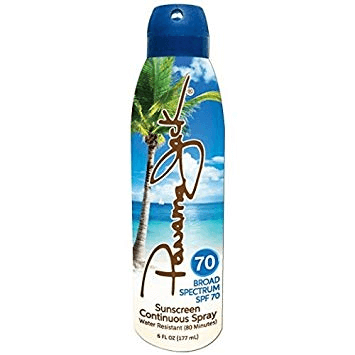
Sunscreen aerosol sprays may look like a comfortable way of protecting your skin, but in reality they come with more risks than benefits. First of all, aerosol sunscreens are easily inhaled, and their toxic components will be then absorbed much faster, and at higher rates. Secondly, aerosol sunscreens don’t cover the skin evenly, often leaving large areas without any protection at all. Besides these issues, the Panama Jack Sunscreen Spray also features an unhealthy SPF level and the dangerous oxybenzone, among other toxic compounds.
3. Neutrogena Ultra Sheer Body Mist Sunscreen Spray, SPF 100+
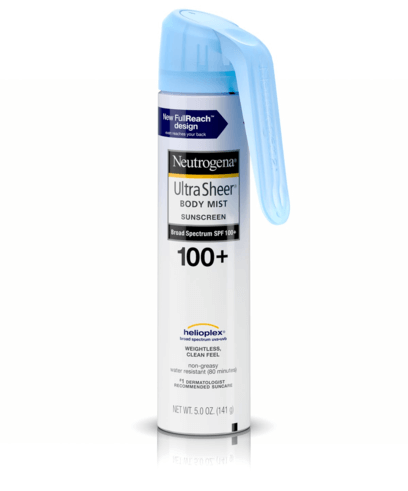
If sunscreen sprays are dangerous for your health, body mists are even more so. The particles in a body mist are much smaller than the droplets in a regular spray. As a result, these tiny particles can travel much deeper into the lungs, and cause damage in hard-to-reach places of the respiratory system. Combine that with unacceptably high SPF level and the presence of oxybenzone, and it becomes clear why this sunscreen is one of the worst products in 2020.
4. Banana Boat Kids Max Protect & Play Sunscreen Lotion, SPF 100
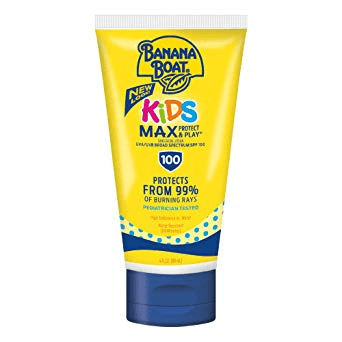
Selling toxic sunscreens to adults is already bad, but trying to market unhealthy products as kid-friendly is downright awful. This lotion features an excessively high SPF, oxybenzone, a few other ingredients with a questionable safety profile, and even propylparaben—a compound with endocrine-disrupting properties, according to studies.(9)
5. Panama Jack Sport Sunscreen Lotion, SPF 50+
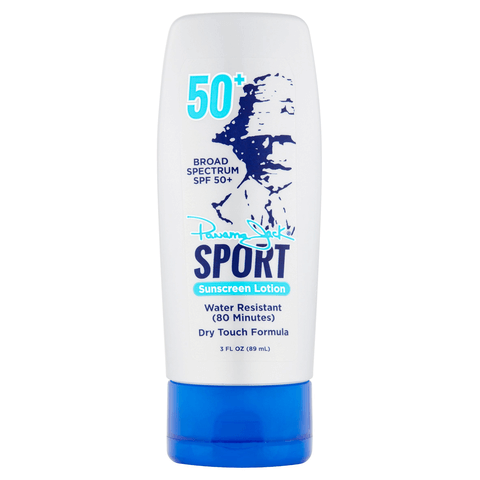
Besides oxybenzone, this sunscreen contains methylisothiazolinone—a known skin allergen that’s banned as an ingredient in leave-on cosmetics in Europe. As if that wasn’t enough, the ingredients label features at least two parabens, methylparaben and propylparaben. Too many red flags for a single product.
Need some more information on sunscreen ingredients, products, and everything related? Don’t forget to check out the2019 annual EWG report on sunscreens!
Healthy Sunscreen Use Tips
Buying a healthy sunscreen isn’t enough to protect you from the sun: you have to use it the right way too! More often than not, people just don’t apply their sunscreens as instructed. So how should you do it for optimal UV protection?
Here’s a quick rundown of the most important healthy sunscreen use tips you should know.
1. With sunscreens, more is better than less
The most common mistake people make when using sunscreens is applying too little of the formula. Remember, you can’t overdose on a topically applied sunscreen, but you can decrease its effectiveness if you put too little of it. According to studies, an adequate dose of sunscreen is about 1 oz (30 mL) of sunscreen for the whole body—that’s roughly a shot glass.(10)
2. Timing is important too, so apply early
Another common issue is that some customers put on their sunscreen when they’re already outside in the sun, or even immediately before jumping into the water. Ideally, you should apply your sunscreen 15 to 30 minutes before sun exposure. Moreover, no matter what sunscreen product you choose, do your best to reapply it every 1.5 to 2 hours. Swimming and sweating is another reason to reapply your sunscreen.(11)
3. Never rely on sunscreen alone
Even when using one of the best sunscreens out there, remember that it should always be your last resort in terms of sun protection.(1)
Don’t forget about the other methods:
- Wear clothes. According to studies, colored and loose clothes provide the best UV protection.(12)
- Avoid the sun when it’s most dangerous. The levels of UV radiation vary throughout the day, reaching their peak intensity in the 3-hour time window around local noon. (13) In other words, it’s generally a wise idea to avoid direct sun exposure from 9 AM to 3 PM.
- Stay in the shade whenever possible, and bring your own shade too. As a personal element of sun protection, hats are particularly effective. For example, a hat with a brim of 3 inches (about 7.5 cm) offers an estimated SPF around 7 for the nose area and 3 for the cheeks.(11)
- Your eyes need protection too. Too much UV exposure increases the risk of developing cataracts and macular degeneration. Wear sunglasses to mitigate this issue, preferably ones that block light wavelengths under 400 nm, as these are the most dangerous in terms of UV damage to the eyes.(14)
4. Get protection from both UVA and UVB
There are three types of ultraviolet radiation—UVA, UVB, and UVC. Sunlight consists mostly of UVA (up to 95%) and UVB (5 to 10%), while UVC is absorbed by the ozone in the atmosphere. UVA has a longer wavelength and thus reaches deeper layers of the skin, and UVB is completely absorbed by the upper layers of the skin. As a result, UVA is a major risk factor for skin cancer, while UVB mostly causes skin damage and sunburns.(15) Ideally, your sunscreen should protect you from both types of ultraviolet rays, so look for products with zinc oxide as their main ingredient.
5. Keep an eye on your sunscreen’s expiration date
The active ingredients in sunscreens slowly degrade and get unstable over time, making the product less and less effective with every passing month. On average, the shelf life of a sunscreen is just three years unless otherwise stated by the manufacturer.(16) Remember that extreme temperatures and direct sunlight exposure also affect the stability of sunscreen compounds.
References:
- https://www.ewg.org/sunscreen/
- https://www.ncbi.nlm.nih.gov/pubmed/28401272
- https://jamanetwork.com/journals/jama/article-abstract/2733085
- https://www.ncbi.nlm.nih.gov/pmc/articles/PMC4997468/
- https://www.ncbi.nlm.nih.gov/pubmed/30831214
- https://www.ncbi.nlm.nih.gov/pubmed/26910569
- https://www.ncbi.nlm.nih.gov/pmc/articles/PMC3299230/
- https://www.ncbi.nlm.nih.gov/books/NBK459173/
- https://www.ncbi.nlm.nih.gov/pubmed/20381602
- https://www.ncbi.nlm.nih.gov/pubmed/11978139
- https://www.ncbi.nlm.nih.gov/books/NBK537164/
- https://www.ncbi.nlm.nih.gov/pmc/articles/PMC3482794/
- https://www.ncbi.nlm.nih.gov/pmc/articles/PMC6025391/
- https://www.ncbi.nlm.nih.gov/pubmed/21617534
- https://www.ncbi.nlm.nih.gov/pmc/articles/PMC3709783/
- https://www.ncbi.nlm.nih.gov/pmc/articles/PMC6773941/



